The Underrecognized Challenge of OCD in Aging Populations
Obsessive-Compulsive Disorder (OCD) presents unique challenges in aging adults, a group often overshadowed in mental health discussions. Recognizing OCD symptoms—characterized by intrusive obsessions and compulsions—is crucial as they significantly impair functioning and quality of life. Aging adults face increased vulnerability due to overlapping mental health issues and social stressors. This article explores the nuances of obsessive-compulsive behaviors among older adults, the intersection with substance use disorders, and comprehensive treatment approaches suited for this population.
Prevalence and Core Features of OCD in Older Adults
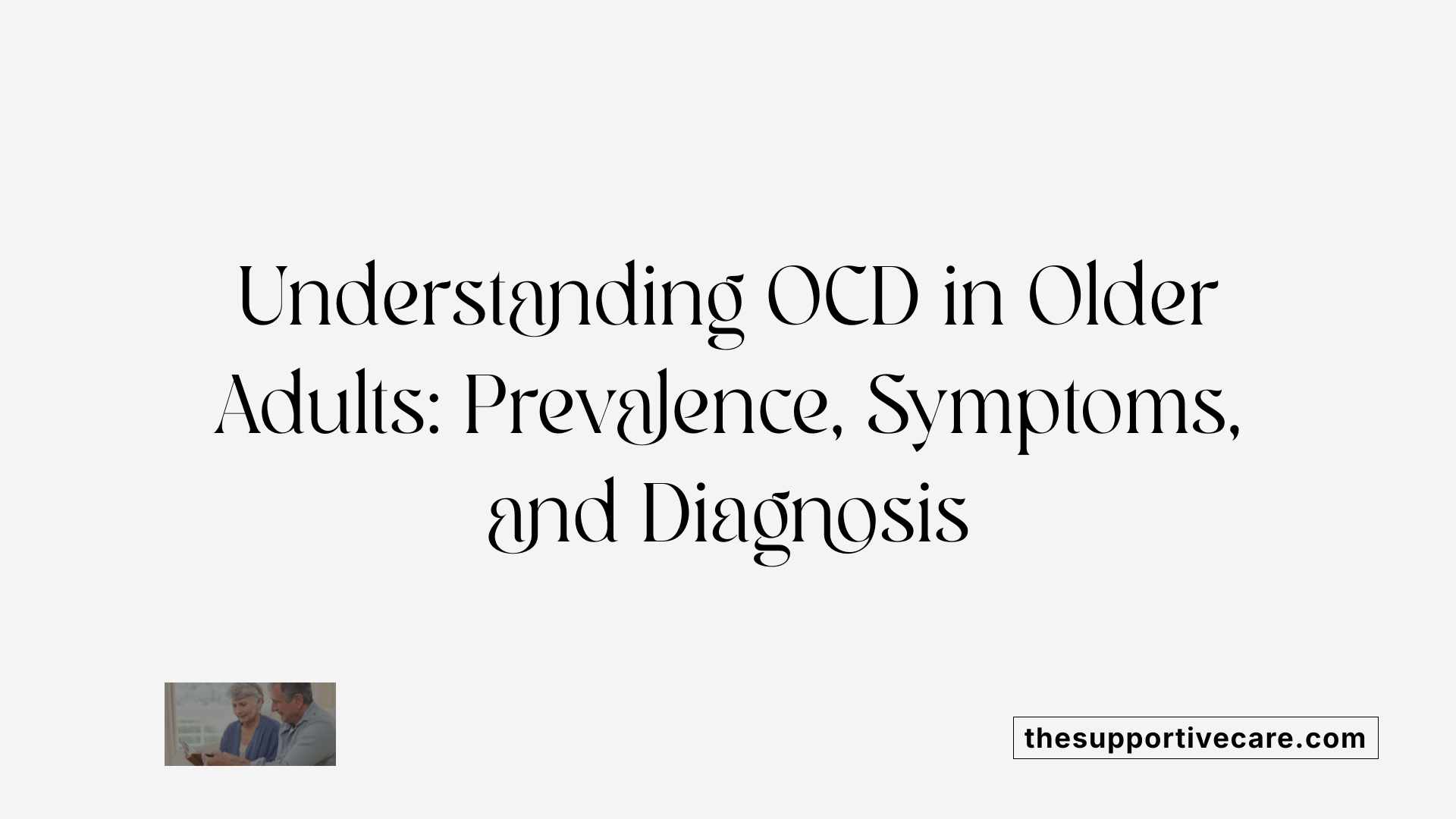
What is the typical presentation and prevalence of OCD?
Obsessive-Compulsive Disorder (OCD) affects about 1% to 3% of people worldwide. It commonly begins in adolescence but can persist into older adulthood, impacting daily functioning significantly. Women tend to be affected at higher rates than men, with prevalence roughly 1.6 times greater.
What are the core symptoms of OCD?
OCD is characterized by two primary symptom types:
- Obsessions: Intrusive and unwanted thoughts, urges, or images that cause considerable anxiety or distress.
- Compulsions: Repetitive behaviors or mental rituals performed to alleviate the distress caused by obsessions or to prevent feared outcomes.
These symptoms can be time-consuming and interfere substantially with an individual's life.
How is OCD diagnosed according to DSM-5 TR?
The diagnosis of OCD follows strict clinical criteria outlined in the DSM-5 Text Revision. Symptoms must:
- Include obsessions, compulsions, or both.
- Occupy at least one hour per day.
- Cause significant distress or impair social, occupational, or other important areas of functioning.
This standardized approach helps ensure accurate identification and treatment planning, especially important for older adults who may experience overlapping mental health concerns.
Prevalence by gender and onset age
OCD onset commonly occurs in adolescence but is lifelong. Women are affected more frequently than men. Understanding these demographic features assists clinicians in early recognition and intervention, particularly as aging adults face distinct mental health challenges.
| Feature | Detail | Implications for Older Adults |
|---|---|---|
| Prevalence | 1% to 3% globally | OCD persists into older age, requiring ongoing care |
| Gender Differences | Women affected 1.6x more than men | Screening may need gender-sensitive approaches |
| Typical Onset | Adolescence | Early identification can improve lifelong outcomes |
| Symptom Duration | ≥1 hour daily, distressing | Symptoms can impair aging adults’ quality of life |
Identifying OCD in older adults requires awareness of its persistent symptoms and their impact, emphasizing the need for comprehensive assessment guided by DSM-5 TR criteria.
Recognizing OCD Symptoms in Aging Adults: Challenges and Misconceptions

What challenges exist in recognizing OCD in older adults?
Recognizing OCD in aging adults poses several difficulties. Symptoms of OCD, such as intrusive thoughts and compulsive behaviors, can be obscured by or misinterpreted as manifestations of neurocognitive disorders like dementia or mood disorders such as depression and schizophrenia. This overlap often leads to underdiagnosis or misdiagnosis.
Moreover, social stigma and ageism negatively affect the identification of OCD in elderly populations. Caregivers and healthcare providers may have limited mental health literacy related to this age group, which can further complicate the recognition of obsessive-compulsive symptoms.
In older adults, OCD symptoms may present differently compared to younger individuals. Compulsive behaviors might be less obvious, and obsessive thoughts may be expressed less overtly, making timely diagnosis and intervention more challenging. These subtleties require heightened clinical awareness to avoid overlooking OCD in this vulnerable population.
Overlap with other mental disorders affects diagnosis
Older adults frequently face comorbid mental health conditions, which can resemble or mask OCD features. Neurocognitive decline, mood disturbances, and psychotic symptoms add complexity to clinical assessments. Differentiating OCD compulsions from repetitive behaviors linked to other psychiatric or cognitive disorders mandates careful evaluation.
Social stigma and ageism hinder effective diagnosis
Age-related biases and societal stigma about mental illness reduce the likelihood of older adults reporting symptoms or seeking help. Additionally, limited access to specialized geriatric mental health services can impede comprehensive evaluations, delaying appropriate care.
Addressing these challenges requires multidisciplinary approaches, improved education for providers, and incorporation of screening tools tailored to detect OCD in older populations. Enhancing awareness can foster earlier recognition, leading to better management and improved quality of life for aging adults living with OCD.
The Impact of Co-occurring Mental Health and Addiction Disorders in Older Adults with OCD
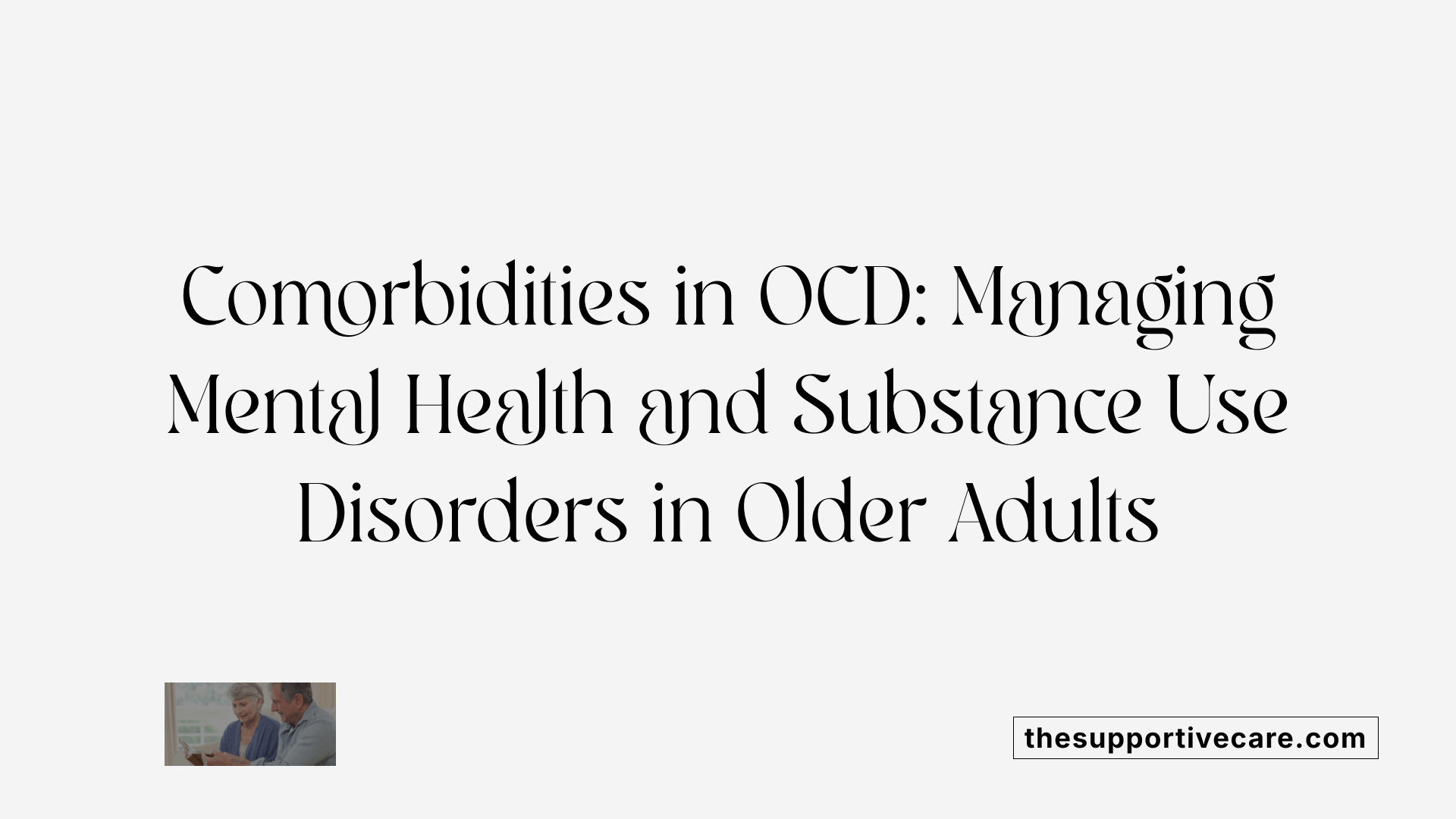
How do comorbid mental health and substance use disorders affect OCD?
Obsessive-compulsive disorder (OCD) rarely occurs in isolation. Over 90% of individuals with OCD also meet criteria for at least one additional psychiatric disorder. These commonly include anxiety and mood disorders, impulse-control conditions, and substance use disorders (SUDs). Such co-occurrence is particularly impactful for older adults managing OCD alongside these complex challenges.
High rates of psychiatric comorbidities with OCD
Psychiatric comorbidity in OCD patients markedly amplifies the overall clinical burden. Anxiety disorders and depression are frequently present, often intensifying OCD symptom severity and increasing functional impairment. Additionally, the presence of SUDs, especially involving alcohol, cannabis, and cocaine, complicates clinical management, leading to poorer response to standard treatments.
Common co-occurring disorders: Anxiety, mood, substance use
Anxiety and mood disorders are the most pervasive comorbidities, influencing the persistence and distress caused by obsessive thoughts and compulsive behaviors. Substance use disorders also represent a significant concern; approximately 27% of individuals seeking OCD treatment meet lifetime criteria for SUDs. In older adults, these overlapping conditions elevate the risk of suicidal ideation and reduce quality of life.
Influence on symptom severity and treatment response
Comorbid disorders not only intensify OCD symptoms but also predict poorer treatment outcomes. Individuals with co-occurring SUDs or severe mood disorders often display higher symptom severity, reduced insight, and resistance to first-line treatments such as cognitive-behavioral therapy (CBT) and selective serotonin reuptake inhibitors (SSRIs). These factors underscore the necessity for comprehensive assessments and integrated treatment plans.
Given the prevalence and impact of these comorbidities, screening for co-occurring psychiatric and substance use disorders is essential in older adults with OCD. Tailored interventions that address both OCD symptoms and coexisting conditions offer the best chance for improved functioning and recovery in this vulnerable population.
Substance Use Disorders Among Older Adults with OCD: Patterns and Risks
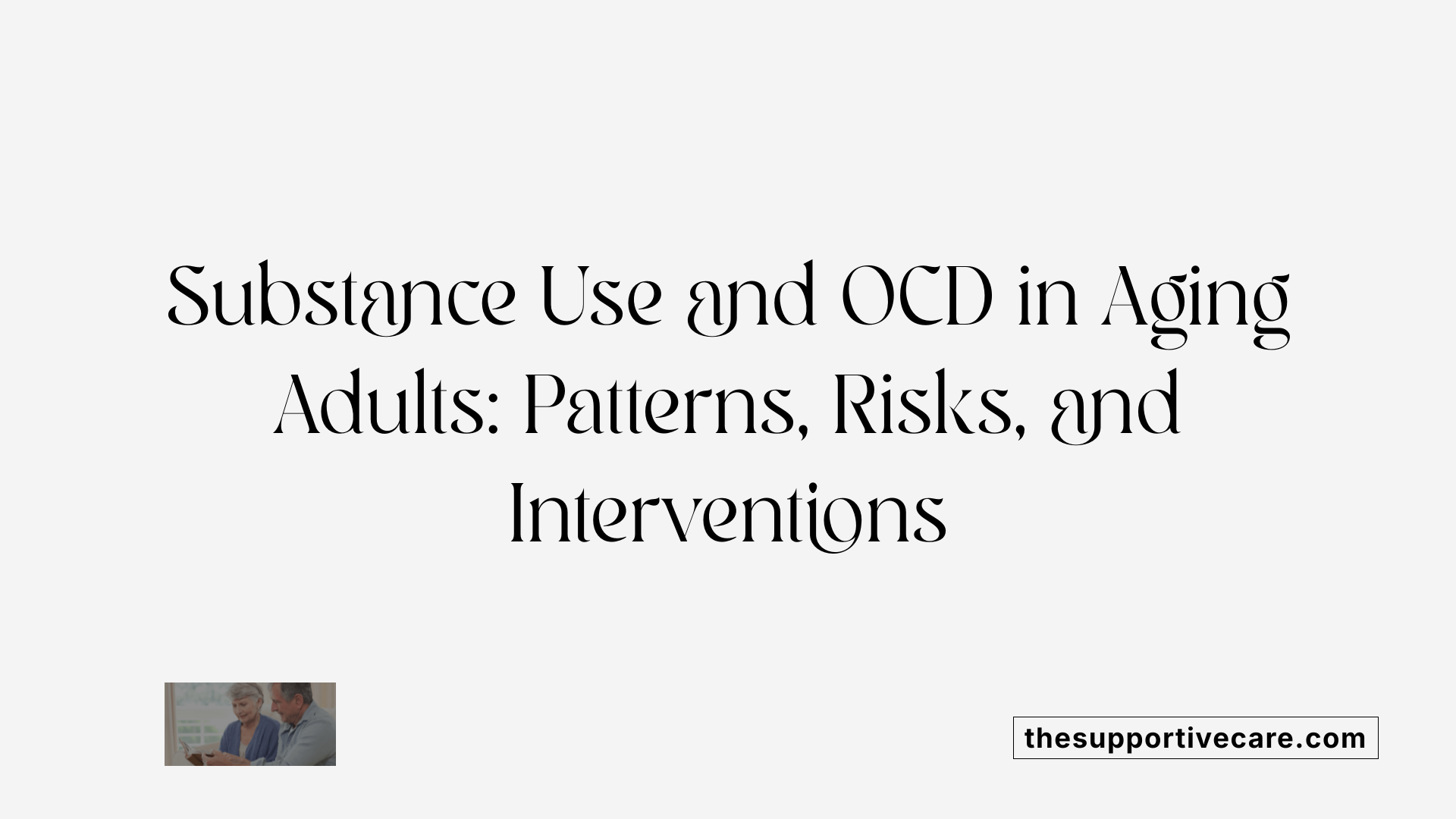
What is the relationship between OCD and substance use disorders?
Obsessive-compulsive disorder (OCD) frequently coexists with substance use disorders (SUDs), with co-occurrence rates varying widely from under 10% to nearly 40%. Approximately 27% of individuals seeking treatment for OCD meet lifetime criteria for a substance use disorder. This significant overlap highlights the need for thorough assessment and integrated treatment strategies.
Which substances are most commonly abused?
Among people with OCD who develop SUDs, the substances most frequently abused include:
- Alcohol
- Cannabis
- Cocaine
These substances may be used by individuals attempting to self-medicate or alleviate distress caused by intrusive thoughts and compulsive symptoms.
How do juvenile-onset OCD and Borderline Personality Disorder influence the risk of substance use disorders?
Individuals with juvenile-onset OCD face a higher risk for developing co-occurring SUDs. Additionally, those diagnosed with comorbid Borderline Personality Disorder (BPD) are more vulnerable to substance abuse. These factors indicate a need for targeted screening and early intervention in these populations to prevent the escalation of substance-related problems.
What motivates substance use in individuals with OCD?
While both OCD and SUDs involve compulsive behaviors, their motivations differ. OCD compulsions are primarily driven by a desire to reduce distress from obsessive thoughts, whereas substance use in SUDs is reinforced by pleasure and reward. Some individuals with OCD turn to substances as maladaptive coping mechanisms to manage their symptoms, which can worsen impairment and complicate treatment outcomes.
Understanding these patterns and risks is essential for clinicians to design comprehensive care plans that address the unique challenges faced by older adults living with both OCD and substance use disorders.
Understanding Neural and Genetic Underpinnings of OCD Relevant to Aging Adults
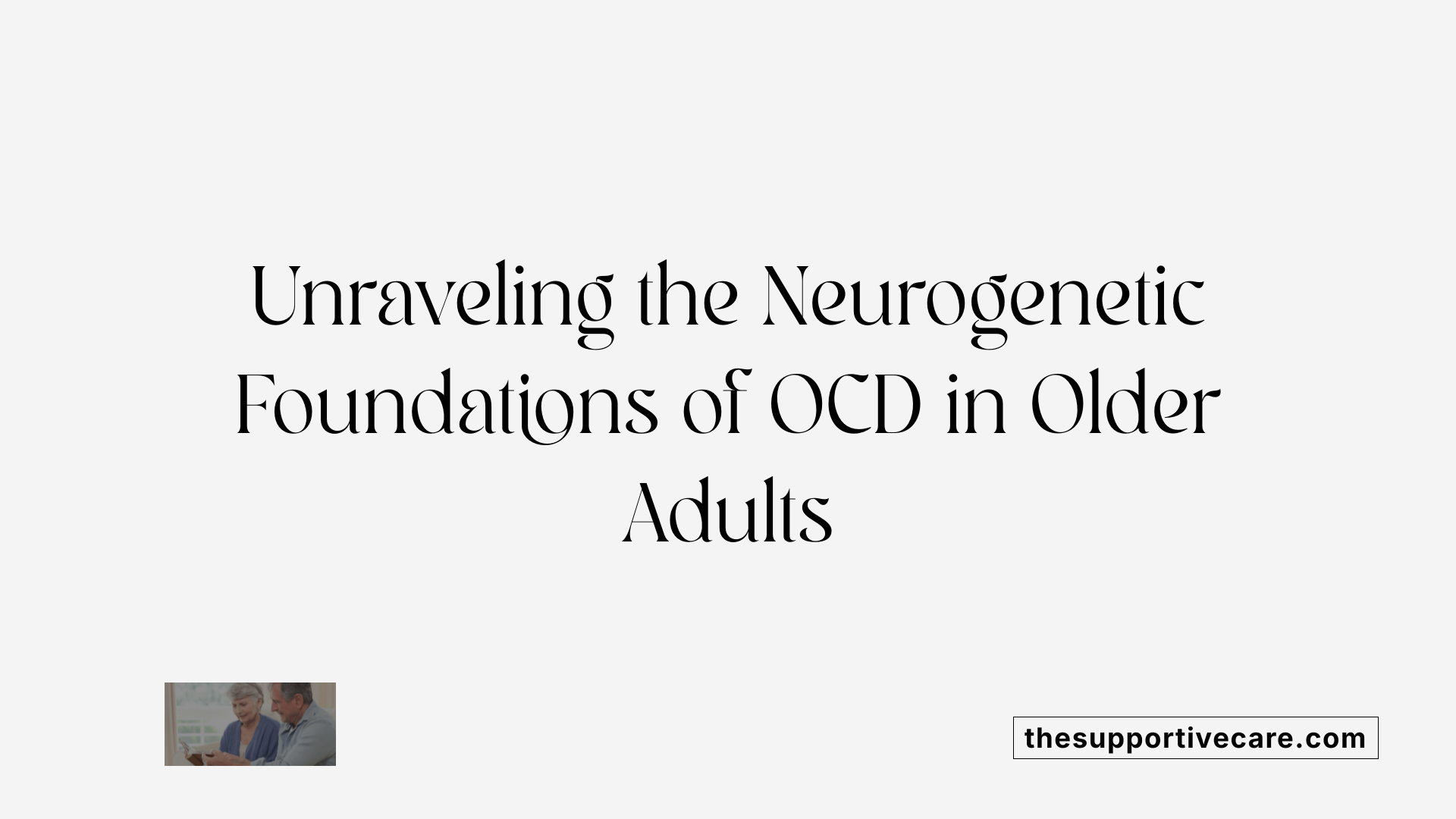
Genetic Heritability Estimates
OCD has a significant genetic component, with heritability estimated at around 48%. This means that nearly half of the risk for developing OCD can be attributed to genetic factors. These genetic predispositions can influence the onset and persistence of the disorder, including among aging adults.
Neural Circuitry Involved
The pathophysiology of OCD centers on hyperactivity within the cortico-striato-thalamo-cortical (CSTC) loop. This neural circuit is crucial for regulating habitual behaviors and decision-making processes. Dysregulation here leads to the hallmark intrusive thoughts and compulsive actions seen in OCD.
Role of Neurotransmitters
Multiple neurotransmitter systems contribute to OCD symptoms. Serotonin has been traditionally implicated, which explains the effectiveness of SSRIs in treatment. Emerging research also highlights the glutaminergic system and dopamine pathways as important players, adding complexity to understanding OCD's neurochemical basis.
Possible Autoimmune Mechanisms in Onset
Particularly in pediatric cases but potentially relevant across ages, autoimmune processes are gaining attention. PANDAS and PANS represent conditions where autoimmune reactions trigger sudden OCD onset or exacerbations. This suggests that immune system dysfunction might influence OCD pathogenesis, which could have implications for aging adults with new or worsening symptoms.
These neural and genetic insights into OCD emphasize the disorder’s complex biology, which is crucial for tailoring effective interventions for older adults facing OCD symptoms, often alongside other age-related mental health challenges.
The Role of Social Determinants in OCD and Mental Health Among Older Adults
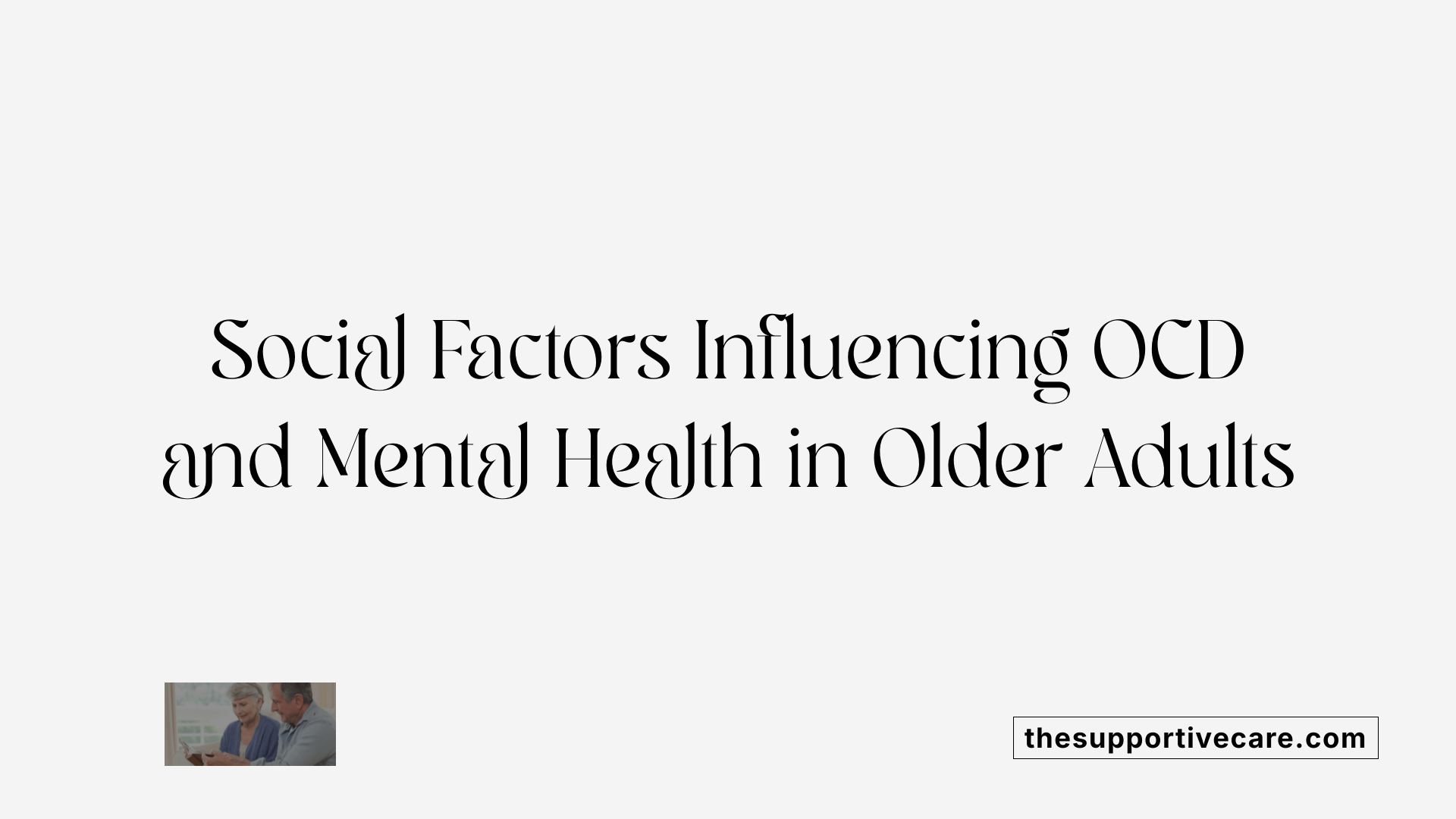
How Do Social Isolation, Loneliness, and Stigma Impact Mental Health in Older Adults?
Social isolation and loneliness are significant factors that worsen mental health outcomes in older adults, including those with conditions like OCD. Feeling disconnected from social networks contributes to increased distress, exacerbation of symptoms, and poor overall quality of life. Additionally, stigma related to mental illness can discourage older adults from seeking help or adhering to treatment, thus hindering their recovery and increasing the risk of chronic impairment.
What Is the Influence of Ageism and Workforce Shortages on Mental Health Care?
Ageism—negative attitudes and stereotypes about aging—affects the delivery and accessibility of mental health services for older adults. It can lead to underdiagnosis, undertreatment, and reduced prioritization of mental health needs. Workforce shortages in geriatric mental health compound these challenges by limiting the availability of specialized care, reducing timely interventions and comprehensive support for conditions like OCD and other psychiatric disorders.
How Does Community Engagement Serve as a Protective Factor?
Active involvement in community activities provides older adults with social support, purpose, and resilience against mental health decline. Community engagement fosters connections that alleviate loneliness and counteract stigma. This protective factor can buffer against the debilitating effects of OCD and co-occurring mental illnesses by promoting emotional well-being and encouraging adherence to treatment and healthy lifestyles.
By recognizing and addressing these social determinants, clinicians and service providers can enhance mental health outcomes and quality of life for older adults living with OCD and other mental disorders.
Integrating Care for OCD, Substance Abuse, and Mental Health Disorders in Older Adults
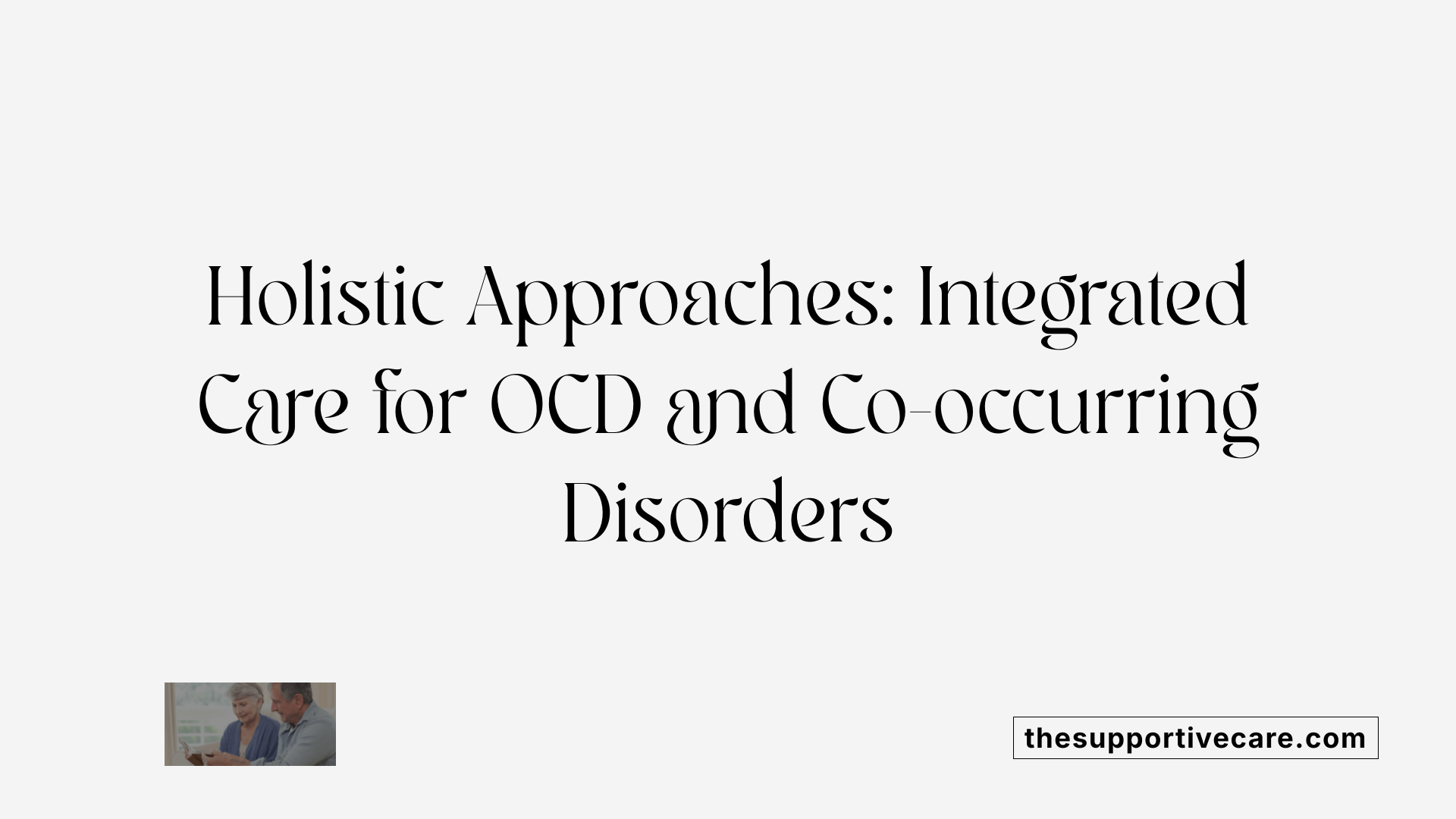
How do comprehensive treatment services integrate care for both substance abuse and mental health issues?
Comprehensive treatment for older adults with OCD and co-occurring substance use disorders (SUDs) relies on multidisciplinary teams that bring together psychiatrists, psychologists, social workers, and primary care providers. These teams collaborate to deliver coordinated care that simultaneously targets obsessive-compulsive symptoms, substance abuse challenges, and other mental health conditions.
Multidisciplinary team approaches
Teams ensure holistic assessment and management of complex cases by combining expertise in mental health, addiction medicine, and geriatric care. This approach facilitates outreach, ongoing monitoring, and integration of physical, social, and psychological health services—all critical to addressing the unique needs of aging adults experiencing multiple disorders.
Coordinated and evidence-based interventions
Treatment integrates evidence-based therapies such as cognitive-behavioral therapy, including exposure and response prevention for OCD, along with motivational interviewing to address substance use. Family and group therapies provide social support, while screening tools help identify symptoms early. Interventions aim to improve symptom control, promote recovery, and prevent relapse across disorders.
Stage-wise and motivational treatment
Clinicians adopt a stage-wise model that meets patients where they are in their readiness for change, progressively introducing motivational strategies to encourage engagement with therapy and abstinence. This flexibility optimizes treatment adherence, especially in conditions complicated by poor insight or comorbidities.
Medication management strategies
Pharmacotherapy involves selective serotonin reuptake inhibitors (SSRIs) tailored to OCD, often augmented with antipsychotics in refractory cases. Medications including naltrexone and disulfiram address substance use disorders effectively and safely in older adults. Medication plans are continuously reviewed to balance efficacy with side effect profiles, particularly given age-related pharmacodynamics.
By integrating multidisciplinary expertise, evidence-based behavioral therapies, motivational approaches, and carefully managed pharmacological treatments, comprehensive services improve overall outcomes. These services also work to enhance social functioning, reduce hospitalization, and strengthen community engagement for older adults living with OCD, substance use, and related mental health disorders.
Comprehensive Treatment Services Addressing OCD and Related Disorders
What types of addiction and mental health issues are typically addressed in comprehensive treatment services?
Comprehensive treatment programs address a wide range of substance use disorders including alcohol, opioids, nicotine, cannabis, and cocaine, which are commonly abused among individuals with obsessive-compulsive disorder (OCD). Behavioral addictions such as gambling and internet addiction may also be treated, especially given the overlap with compulsive behaviors seen in OCD.
Mental health conditions that frequently coexist with OCD and are targeted in these services include depression, anxiety disorders, bipolar disorder, trauma-related disorders, and personality disorders. Given that over 90% of individuals with OCD have at least one comorbid psychiatric condition—including substance use disorders—integrated treatment approaches are essential to address this complexity.
Treatment settings: inpatient, outpatient, and residential care
Treatment is delivered across diverse settings tailored to patient needs. Inpatient and residential programs provide intensive 24-hour care and stabilization for severe symptoms or high-risk cases, such as those involving suicidality or extensive comorbidity. Outpatient services offer flexibility while maintaining structured therapy and medication management for individuals with milder or stabilized symptoms. Stepped care models enable smooth transitions between these levels based on treatment response and patient progress.
Behavioral and pharmacological interventions
Cognitive-behavioral therapy (CBT), especially exposure and response prevention (ERP), forms the cornerstone of behavioral treatment for OCD symptoms and co-occurring disorders. Pharmacotherapy predominantly involves selective serotonin reuptake inhibitors (SSRIs), tailored to dosage needs in OCD, with augmentation by antipsychotics or other agents in treatment-resistant cases.
For substance use disorders, medications such as naltrexone and disulfiram are commonly incorporated, alongside behavioral treatments targeting cravings, impulse control, and relapse triggers. Neuromodulation techniques may be considered in refractory OCD but are less common in integrated addiction programs.
Relapse prevention and ongoing support
Sustained recovery hinges on comprehensive relapse prevention strategies. These include ongoing therapy to reinforce coping mechanisms, medication adherence monitoring, and addressing social determinants like isolation or stigma that can increase relapse risk.
Case management and peer support play crucial roles in maintaining engagement and connecting patients to community resources. Personalized care plans acknowledge the chronic nature of OCD and substance use disorders, fostering resilience and wellness while aiming for long-term remission.
| Aspect | Description | Importance |
|---|---|---|
| Range of Disorders | Substance use (alcohol, cannabis, opioids), behavioral addictions, co-occurring mental disorders | Addresses wide clinical needs and complexity |
| Treatment Settings | Inpatient, outpatient, residential | Customizable intensity and flexibility in care delivery |
| Behavioral Treatments | CBT with ERP, social skills training, relapse prevention counseling | Evidence-based symptom reduction and skill building |
| Pharmacological Care | SSRIs, antipsychotics, naltrexone, disulfiram | Target underlying neurochemical pathways and reduce cravings |
| Relapse Prevention | Continued therapy, medication adherence, peer support, social integration | Supports sustained recovery and improves quality of life |
Effective Therapeutic Approaches for OCD and Co-occurring Disorders in Older Adults
What approaches or therapies are commonly used in comprehensive treatment programs for addiction and mental health?
Comprehensive treatment programs for older adults with OCD and co-occurring disorders rely on a combination of therapies to address both the obsessive-compulsive symptoms and associated substance use disorders effectively.
Cognitive-behavioral therapy with exposure and response prevention
Cognitive-behavioral therapy (CBT), particularly exposure and response prevention (ERP), is the cornerstone of psychotherapy in OCD treatment. ERP helps individuals face anxiety-provoking obsessive thoughts without engaging in compulsive behaviors, reducing symptom severity over time. In older adults, CBT is often adapted to consider cognitive or physical limitations and is combined with social skills training and community engagement to enhance outcomes.
Pharmacotherapy such as SSRIs and augmentation agents
Selective serotonin reuptake inhibitors (SSRIs) form the first-line pharmacological treatment for OCD, requiring tailored dosing specific to the disorder. For patients showing partial or no response, augmentation with antipsychotics or other agents might be necessary. This layered pharmacotherapy is crucial in managing symptoms and improving quality of life among older adults, who may also present with complex medical profiles.
Neuromodulation and advanced techniques for refractory cases
For refractory OCD cases resistant to conventional treatment, advanced neuromodulation techniques are viable options. Transcranial magnetic stimulation (TMS) offers a non-invasive approach to modulate neural circuits implicated in OCD. Deep brain stimulation (DBS) and stereotactic ablation represent more invasive but effective interventions targeting hyperactivity in brain circuitry associated with the disorder, particularly beneficial when standard therapies fail.
Integrative and holistic approaches
Holistic care models recognize the intricate interplay between mental health, physical health, and social factors in older adults. Treatment plans incorporate psychosocial interventions and address social determinants such as isolation and stigma, while promoting resilience and caregiver involvement. This comprehensive framework aims not only at symptom reduction but also at enhancing overall wellness, purpose, and community integration for aging individuals grappling with OCD and co-occurring substance use disorders.
Screening and Early Identification of OCD in Older Adults
Screening Tools Such as Online Questionnaires
Early detection of obsessive-compulsive disorder (OCD) in older adults is essential for timely intervention. Online screening questionnaires, like those provided by the Anxiety and Depression Association of America, serve as accessible initial tools. These brief self-assessments help identify symptoms indicative of OCD, such as intrusive thoughts and compulsive behaviors, providing a pathway for individuals or caregivers to seek further clinical evaluation.
Importance of Early Referral
Once screening suggests possible OCD, early referral to mental health professionals ensures comprehensive assessment and initiation of treatment. Early intervention can mitigate symptom severity, prevent complications, and promote recovery. In older adults, who often face overlapping mental health issues and complex health needs, prompt referral allows tailored, multidisciplinary care addressing cognitive, psychiatric, and social factors.
Barriers to Screening in Aging Populations
Several challenges hinder OCD screening in older adults. Social isolation, stigma, and limited mental health literacy can reduce willingness to report symptoms or seek help. Additionally, symptoms may be overlooked or mistaken for normal aging or other neurocognitive disorders. Healthcare workforce shortages and limited specialized geriatric psychiatry resources further restrict screening access.
How Can Individuals Access Comprehensive Treatment Services for Addiction and Mental Health Challenges?
Access typically begins through healthcare provider referrals or community resource contacts, which may include online platforms with initial assessments. These referrals facilitate individualized treatment plans encompassing outpatient, residential, and telehealth options, enhancing accessibility for older adults. Screening tools help identify co-occurring disorders, such as substance use and OCD, enabling integrated care approaches. Overcoming barriers like stigma and awareness is crucial to connecting aging adults with effective services.
By promoting widespread use of screening tools and ensuring streamlined referral pathways, healthcare providers can better address OCD and related conditions in the aging population, improving mental health outcomes and quality of life.
Benefits of Addressing OCD and Substance Use Together in Treatment
What are the benefits of addressing mental health and addiction issues together in treatment?
Treating obsessive-compulsive disorder (OCD) alongside substance use disorders (SUDs) offers several significant advantages that improve overall patient outcomes. When these conditions are addressed concurrently, symptom management becomes more effective because both disorders often share underlying compulsive behaviors and neurobiological pathways. Integrated treatment approaches help reduce relapse rates by simultaneously targeting the obsessive thoughts and compulsive urges along with addictive behaviors, which often serve as maladaptive coping mechanisms.
Patients receiving combined care show enhanced engagement in their recovery journey. This happens because comprehensive programs integrate therapy methods like cognitive-behavioral therapy (CBT) with medication management tailored to both disorders. Exposure and response prevention (ERP), a first-line therapy for OCD, can be particularly effective when harmonized with addiction treatments including pharmacotherapy for substance cravings.
Moreover, integrated treatment emphasizes not only symptom control but also improved quality of life and overall wellness. By fostering a holistic approach that addresses mental health, addiction, physical health, and social needs, patients benefit from better adherence to treatment and stronger support networks. This multidisciplinary model is especially crucial given the complexities of dual diagnoses where one condition can exacerbate the other.
In sum, the synergy of treating OCD and SUDs together promotes sustained remission, reduces the likelihood of future substance abuse, and supports recovery by addressing the full scope of patients' challenges and strengths.
Psychosocial Interventions Supporting Older Adults with OCD and Related Disorders
Social Skills Training
Social skills training plays a crucial role in helping older adults with OCD and related disorders regain confidence and improve interpersonal interactions. Age-related challenges such as social isolation and loneliness can exacerbate symptoms, so fostering effective communication and social behavior supports mental health and counters stigma.
Community Engagement Programs
Engaging older adults in community activities provides meaningful social interaction and enhances a sense of purpose, which is especially beneficial for those dealing with obsessive-compulsive and related disorders. Community programs help mitigate the impact of isolation, promote resilience, and encourage ongoing participation in social life, which can buffer against mental health decline.
Cognitive-Behavioral Therapy Adaptations for Older Adults
Cognitive-behavioral therapy (CBT), particularly exposure and response prevention (ERP), remains a first-line treatment for OCD across age groups. For older adults, CBT protocols are adapted to accommodate cognitive or physical limitations, often incorporating a slower pace, simplified materials, and a focus on reinforcing coping skills relevant to late-life challenges. These tailored interventions improve treatment accessibility and outcomes.
Together, these psychosocial interventions form an integrated approach to managing OCD and related disorders in older adults, addressing both clinical symptoms and social determinants of mental health.
The Importance of Personalized and Holistic Care in Aging Populations
Treatment personalization considering illness heterogeneity
Mental health disorders in older adults often present with diverse symptoms and varying responses to treatment. For aging individuals with OCD and other co-occurring conditions, personalizing interventions is crucial. Tailoring therapies to accommodate unique illness manifestations, such as differences in OCD symptom severity, comorbid psychiatric conditions, and substance use disorders, enhances treatment effectiveness and supports recovery.
Addressing social determinants and caregiver roles
Social determinants such as isolation, stigma, and workforce shortages substantially impact mental health outcomes in elder populations. Addressing these factors is vital for holistic care. Integrating caregiver support within treatment plans helps manage social complexities and provides essential assistance, promoting treatment adherence and overall well-being.
Promoting resilience and well-being
Fostering resilience, wisdom, and community engagement emerges as a protective factor against mental health decline in older adults. Interventions that prioritize social connectedness, purpose, and wellness contribute to improved quality of life. This approach not only mitigates the effects of aging-related mental disorders but also combats stigma and enhances recovery pathways.
By combining individualized clinical management with social and caregiver support systems and resilience-building strategies, comprehensive geriatric mental health care can effectively address the complex needs of aging populations coping with OCD and related challenges.
Prevention and Early Intervention Strategies in Geriatric Mental Health
Education and vascular risk control
Educating older adults about mental health and promoting vascular risk factor management are crucial prevention strategies. Controlling hypertension, diabetes, and cholesterol can reduce the risk of developing neurocognitive disorders such as Alzheimer's disease. Increased awareness enables early recognition of symptoms and encourages timely medical consultation.
Physical activity benefits
Regular physical activity is a powerful tool to support mental health in older adults. Exercise improves mood, cognition, and overall quality of life by boosting brain plasticity and cardiovascular health. It also helps to combat social isolation and loneliness, which are important social determinants affecting mental well-being in aging populations.
Delaying or preventing neurocognitive disorders
Combining education, vascular risk management, and physical activity forms a multifaceted approach to delay or potentially prevent neurocognitive disorders. Early preventive measures can slow progression and improve outcomes. Innovations such as biomarker screening using PET imaging or blood tests allow earlier detection, further enhancing intervention timing.
These strategies, integrated within multidisciplinary geriatric care, promote resilience and well-being among older adults, ultimately supporting sustained cognitive and emotional health.
Advances in Pharmacotherapy for Older Adults with OCD and Substance Use Issues
New antipsychotics with fewer side effects
Recent pharmacological developments have introduced antipsychotic medications tailored for older adults that minimize metabolic side effects such as weight gain, diabetes, and cardiovascular risks. These newer agents improve tolerability, which is critical for elderly patients managing both OCD and co-occurring conditions like substance use disorders (SUDs).
Medications for tardive dyskinesia
Tardive dyskinesia, a common adverse effect of long-term antipsychotic use, is managed more effectively with emerging treatments approved for elderly patients. These medications help reduce involuntary movements, enhancing quality of life and adherence to psychiatric treatment regimens.
Pharmacological support for substance use disorders
Addressing substance use in older adults with OCD involves medications such as naltrexone and disulfiram. Naltrexone is effective in reducing cravings for alcohol and opioids, while disulfiram supports abstinence by causing adverse reactions when alcohol is consumed. Incorporating these agents alongside OCD treatments supports comprehensive care for this vulnerable population.
These pharmacotherapy advances reflect a growing understanding of the unique challenges faced by older adults with OCD and comorbid substance use issues. Combining newer medications with careful clinical management optimizes treatment outcomes and supports sustained recovery.
Role of Emerging Biomarkers in Early Diagnosis of Mental Disorders in Aging Adults
Amyloid and Tau PET Imaging
Positron emission tomography (PET) imaging targeting amyloid and tau proteins represents a major advance in the early diagnosis of neurocognitive disorders such as Alzheimer's disease. These proteins accumulate abnormally in the brain and can be visualized using specific radiotracers, providing a non-invasive method to detect pathological changes before significant cognitive decline occurs.
Cerebrospinal Fluid and Blood-Based Markers
Alongside PET imaging, measurements of amyloid and tau proteins in cerebrospinal fluid (CSF) serve as reliable biomarkers to support diagnosis. More recently, blood-based biomarkers have emerged, offering less invasive and more accessible options for screening and monitoring disease progression in older adults.
Facilitating Early and Accurate Diagnosis
The integration of these biomarkers into clinical practice enables clinicians to identify neurodegenerative processes at earlier stages. This facilitates timely intervention, potentially delaying onset or progression of cognitive impairment and improving overall outcomes. Early diagnosis also supports tailored treatment plans and informs prognosis, enhancing comprehensive geriatric psychiatry care.
Innovations in Delivery of Mental Health Care for Older Adults
Telehealth expansion
Telehealth has revolutionized access to mental health care for older adults, breaking down barriers such as mobility challenges, transportation issues, and geographic isolation. Especially during the COVID-19 pandemic, telehealth services saw significant growth, enabling older adults to receive timely psychiatric consultations, therapy sessions, and medication management from the comfort of their homes.
Measurement-based and collaborative care models
Measurement-based care involves the systematic use of standardized tools to track symptom progress, treatment response, and side effects. This approach ensures that care is tailored responsively to the individual’s needs. Collaborative care models integrate mental health specialists, primary care providers, and other healthcare professionals to deliver coordinated and comprehensive treatment plans. For older adults, this teamwork improves outcomes for conditions like late-life depression and neurocognitive disorders, by addressing both physical and mental health concurrently.
Role of primary care integration
Primary care often serves as the first point of contact for older adults' health concerns. Integrating mental health services into primary care settings facilitates early identification, timely referral, and the initiation of treatment for mental illness. This integration reduces stigma, improves coordination across specialties, and supports ongoing management, especially for chronic mental disorders common in older populations.
Together, these innovations in care delivery create a more accessible, responsive, and holistic system suited for the complex needs of older adults. They emphasize not only symptom management but also promotion of overall wellness, resilience, and social connectedness critical for aging populations.
Social Engagement and Addressing Loneliness to Improve Outcomes in OCD
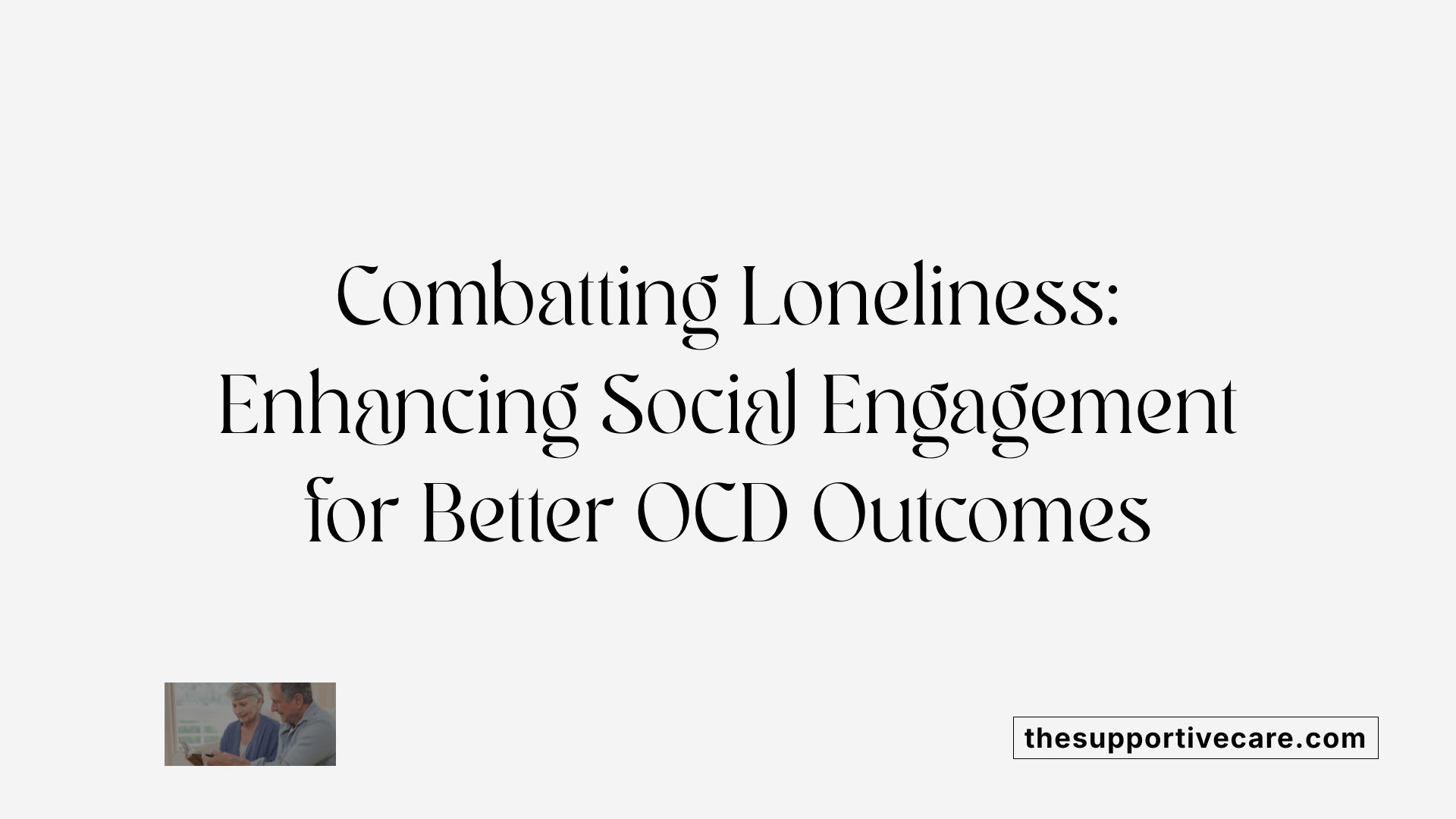
How Does Loneliness Affect Mental Health in OCD?
Loneliness can severely impact mental health, especially in individuals with obsessive-compulsive disorder (OCD). Isolation deepens distress by exacerbating symptoms such as intrusive thoughts and compulsive behaviors. For those with OCD, loneliness often undermines their ability to cope effectively, potentially increasing the risk of co-occurring disorders like anxiety, depression, or substance use. Social isolation also contributes to poorer treatment outcomes, raising the chances of relapse and worsening overall functioning.
What Community Programs Can Help Reduce Isolation?
Community engagement programs play a vital role in connecting individuals with OCD to supportive networks. Examples include peer support groups, mental health advocacy organizations, and local recreational activities designed to foster social interaction. These initiatives provide safe environments for sharing experiences, reduce stigma, and encourage participation in meaningful activities. Such programs not only alleviate loneliness but also support recovery by promoting a sense of belonging and purpose.
How Can Social Connection Build Resilience?
Forming strong social bonds enhances resilience, helping people with OCD better manage stress and emotional challenges. Resilience involves adapting positively in the face of adversity, and close relationships offer emotional support, practical assistance, and validation. Engagement in community and family life can empower individuals to face OCD symptoms more confidently, ultimately improving quality of life. Emphasizing social connection alongside clinical treatment produces a holistic approach to mental health that nurtures wellness and recovery.
Future Directions: Research and Policy to Enhance Care for OCD in Aging Adults
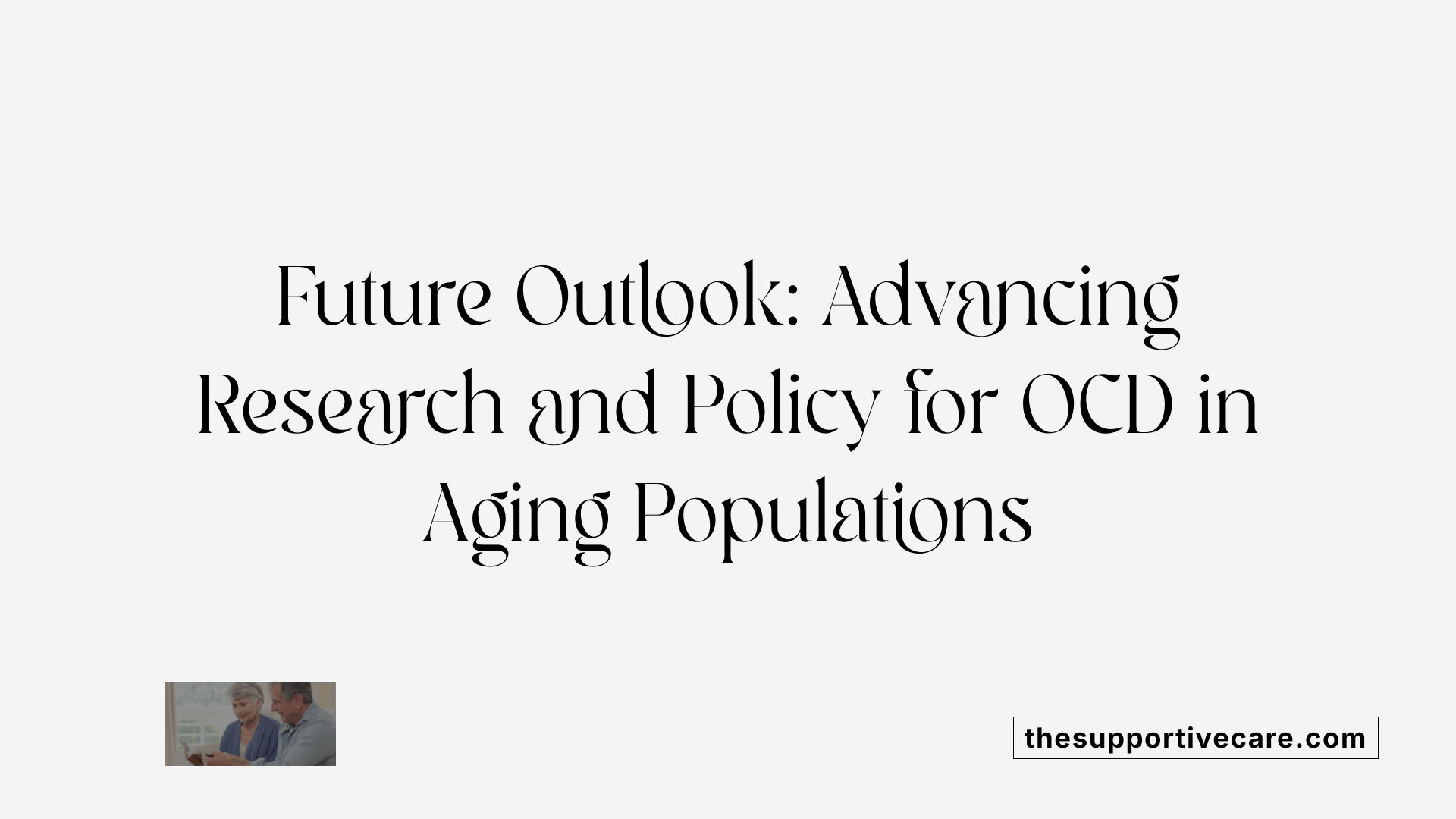
Need for Longitudinal Studies
Long-term, longitudinal research is essential to better understand how OCD presents and progresses in aging adults. Aging introduces unique challenges such as comorbid neurocognitive disorders and complex medical conditions, which can affect symptom expression and treatment response. Studying older populations over time will illuminate disease trajectory, factors influencing treatment resistance, and the impact of OCD on quality of life in late life.
Policy Initiatives for Integrated Geriatric Mental Health Services
Policy efforts should focus on developing integrated care frameworks that combine physical, mental, and social health services tailored for older adults with OCD. This approach includes multidisciplinary teams offering comprehensive assessments, clinical management, outreach, and the coordination of services. Enhanced policies can facilitate access to evidence-based treatments like cognitive-behavioral therapies and pharmacotherapy while supporting mental health promotion and dementia prevention strategies.
Addressing Workforce Shortages and Stigma
Workforce shortages in geriatric mental health care pose significant barriers to adequate OCD treatment in older adults. Investing in professional training programs targeting geriatric psychiatry and psychology is critical. Additionally, policy must aim to reduce stigma and ageism through public education campaigns and community engagement initiatives, empowering older adults, improving social support, and promoting resilience to enhance mental health outcomes.
Together, these future research directions and policy actions can significantly improve the detection, treatment, and overall care experience for aging adults living with OCD.
Advancing Recognition and Care for OCD in Older Adults
Recognizing obsessive-compulsive behaviors in aging adults is essential to improving mental health outcomes in this vulnerable population. Comprehensive, integrated care that addresses both OCD symptoms and co-occurring conditions, including substance use disorders, can substantially enhance quality of life. Addressing social determinants, advancing early detection, and employing evidence-based, personalized treatments are pivotal. As the aging population grows, concerted efforts in research, clinical practice, and policy must prioritize holistic, accessible mental health services that empower older adults to lead fulfilling, resilient lives.
References
- Obsessive-Compulsive Disorder - StatPearls - NCBI Bookshelf
- Advisory: Obsessive-Compulsive Disorder and Substance ...
- Mental health care for older adults: recent advances and new ...
- Substance use disorders in an obsessive compulsive ...
- Advisory: Obsessive-Compulsive Disorder and Substance ...
- Finding Help for Co-Occurring Substance Use and Mental ...
- Mental health & substance abuse coverage
- What is Addiction Treatment?
- Addiction: What It Is, Causes, Symptoms, Types & Treatment
- Find treatment for substance use | Behavioral Health Services



































































































